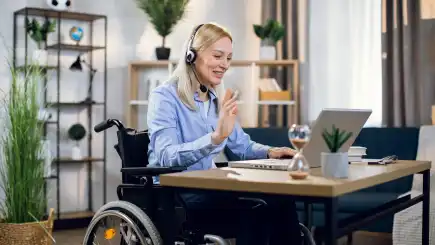Learn accessibility with online courses and programs

What is accessibility?
Accessibility, in the context of real-world application, covers the areas of technology and design. It ensures that individuals with a wide range of abilities, including those with disabilities can access digital content,Footnote 1 physical spaces,Footnote 2 products, and services. The goal is to ensure that individuals with visual, auditory, motor, cognitive, or other impairments can perceive, understand, navigate, and interact with all these resources effectively.
The primary objective of accessibility involves various principles and strategies, such as providing alternative formats for content, such as readers for the visually impaired, keyboard navigation, closed captions for videos, and ensuring that physical locations are wheelchair-accessible.
The main fundamental area of focus in accessibility, is to ensure inclusivity. This allows everyone regardless of their abilities to participate fully in the digital world, and also to engage in physical environments without discrimination. Not only is it a legal requirement in many states, but also a moral and ethical imperative to create a more equitable and inclusive society.
Browse online accessibility courses
Accessibility course curriculum
An online course in accessibility can cover a wide range of topics related to ensuring digital content, physical environments, products, and services are accessible to individuals with diverse disabilities. Topics may include:
Introduction to accessibility: Accessibility fundamentals and its importance.
Web accessibility: Principles of creating websites and digital content that are accessible to people with disabilities, including HTML and WCAG (Web Content Accessibility Guidelines).
Accessible design: Techniques for designing products, interfaces, and environments that accommodate various needs.
Assistive technologies: Tools and technologies used by individuals with disabilities to access digital content, such as screen readers and speech recognition software.
Legal and ethical aspects: Legal requirements and ethical considerations related to accessibility, including compliance with disability discrimination laws.
User experience (UX): The user experience for all individuals and its impact on digital product design.
Courses in accessibility prepare learners with the tools and knowledge needed for creating inclusive digital and physical spaces. edX offers a variety of opportunities for learners interested in studying these topics, as well as a host of other disciplines. A boot camp can provide flexible hands-on learning for those who want to upskill quickly, while executive education programs are designed for busy professionals. You can also pursue a more comprehensive curriculum in a bachelor’s degree program or, for more advanced learners, a master’s degree program. Find the right learning path for you.
Explore accessibility jobs
After completing a course in accessibility, individuals can pursue various career opportunities in fields related to ensuring equal access and usability for people with disabilities. Course criteria may vary depending on the choice of course and experience level of the learner. Some potential job options include:
User experience (UX) designer: Creates user-friendly and accessible digital interfaces, considering the diverse needs of all users.
Web developer: Creates websites and applications that are inclusive and usable for individuals with disabilities.
Digital content manager: Ensures that users can access online content such as articles, multimedia, and documents.
Disability services coordinator: Assists individuals with disabilities to access necessary accommodations and support.
Accessibility specialist: Provides guidance and solutions to organizations striving to make their products, services, and environments more inclusive.
Accessibility compliance officer: Monitors and enforces compliance with accessibility laws and regulations, ensuring that organizations meet accessibility requirements.
Ready to make a difference by ensuring equal access for all? Explore accessibility through online courses on edX. Whether you aim to become an accessibility specialist, a web developer, or a disability services coordinator, our courses can help you find a rewarding career. Start your journey today.
